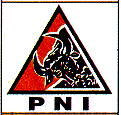Indonesian National Party
Indonesian National Party Partai Nasional Indonesia | |
|---|---|
 | |
| Founder | Sukarno |
| Founded | July 4, 1927 |
| Dissolved | January 11, 1973 |
| Merged into | Indonesian Democratic Party |
| Headquarters | Jakarta |
| Membership (1929) | 10,000 |
| Ideology |
Nationalism Marhaenism |
| International affiliation | None |
The Indonesian National Party (Indonesian: Partai Nasional Indonesia, PNI) is the name used by several political parties in Indonesia from 1927 until the present day.
Pre-independence
On July 4, 1927, Sukarno, a young engineer at the time, and members of the Bandung Study Club formed a movement called the Indonesian National Association. In May 1928, the name was changed to the Indonesian National Party. The organization's aim was economic and political independence for the Indonesian archipelago. This would be achieved by non-cooperation with the Dutch colonial regime. By the end of 1929, the organization had 10,000 members. This alarmed the authorities, and Sukarno and seven party leaders were arrested in December 1929. They were put on trial for being a threat to public order and in September 1930 received sentences of one to three years - Sukarno received the longest sentence. Without its leader, the party was paralyzed and dissolved itself in 1931.[1][2]
Post-independence
Following the Indonesian Declaration of Independence in August 1945, on the same day as the Central Indonesian National Committee (KNIP) was established, August 22, the Indonesian National Party was established as a state party. However, it was dissolved on September 1 as it was deemed unnecessary.[3]
In January 1946, the Indonesian National Party was revived, but this time without Sukarno, who as president, was above politics.[4] The party attracted considerable support due to its having the same name as Sukarno's original party as well as the short-lived party of August 1945.[5] The party had many key governmental posts from 1945 on and won the largest share of votes in the first Indonesian general election in 1955. The party programme embraced above all nationalism; it also favoured a strong centralized government and secularism.[6]
The left wing of the party was purged following the 1965 coup attempt by the 30 September Movement, weakening the party. Along with eight other political parties and the government-sponsored Golkar organization, the PNI contested the 1971 elections. It came third, but won less than 7% of the vote. In 1973, the PNI along with other nationalist and Christian parties was merged into the Indonesian Democratic Party in order to limit the number of political parties and to weaken opposition to the regime.
After the fall of President Suharto in 1998, the part was revived and contested the 1999 legislative election as the Indonesian National Party Marhaenism.[7][8][9]
References
- Bambang Setiawan & Bestian Nainggolan (Eds) (2004) Partai-Partai Politik Indonesia: Ideologi dan Program 2004-2009 (Indonesian Political Parties: Ideologies and Programs 2004-2009 Kompas ISBN 979-709-121-X (Indonesian)
- Evans, Kevin Raymond, (2003) The History of Political Parties & General Elections in Indonesia, Arise Consultancies, Jakarta, ISBN 979-97445-0-4
- Gosnell, Harold F. (1958) Indonesians Go to the Polls: The Parties and their Stand on Constitutional Issues in Midwest Journal of Political Science
- Kahin, George McTurnan (1970), Nationalism and Revolution in Indonesia, Cornell University Press, ISBN 0-8014-9108-8
- Liddle, R. William, The 1977 Indonesian and New Order Legitimacy, South East Asian Affairs 1978, Translation published in Pemilu-Pemilu Orde Baru, LP3ES, Jakarta, ISBN 979-8015-88-6 (Indonesian)
- Ricklefs, M.C. (1982), A History of Modern Indonesia, Macmillan Southeast Asian reprint, ISBN 0-333-24380-3